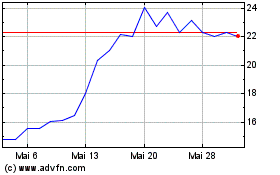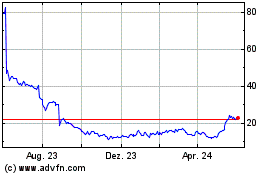PANOVA-3 met its primary endpoint with a
statistically significant improvement in overall survival for
patients with unresectable, locally advanced pancreatic
adenocarcinoma treated in the first line with TTFields concomitant
with gemcitabine and nab-paclitaxel
Novocure plans to file for regulatory approval
in the U.S., EU, Japan and other key markets
Full results from the PANOVA-3 trial will be
presented at an upcoming medical congress
Novocure (NASDAQ: NVCR) announced today that the pivotal, Phase
3 PANOVA-3 trial met its primary endpoint, demonstrating a
statistically significant improvement in median overall survival
(mOS) versus control. PANOVA-3 evaluated the use of Tumor Treating
Fields (TTFields) therapy concomitantly with gemcitabine and
nab-paclitaxel as a first-line treatment for unresectable, locally
advanced pancreatic adenocarcinoma.
“As a researcher and clinician, I have experienced the
challenges of developing treatments in pancreatic cancer. It is
exciting to see the PANOVA-3 trial achieve the positive primary
endpoint of overall survival, a landmark outcome for this field,”
said Vincent Picozzi, M.D., medical oncologist and investigator in
the PANOVA-3 trial. “These data for Tumor Treating Fields are very
promising, especially in this difficult to treat patient
population.”
In the intent-to-treat population, patients treated with
TTFields therapy concomitant with gemcitabine and nab-paclitaxel
had an mOS of 16.20 months compared to 14.16 months in patients
treated with gemcitabine and nab-paclitaxel alone, a statistically
significant 2.0-month improvement (hazard ratio=0.819; P=0.039)
(N=571). The survival rate benefit for patients treated with
TTFields therapy increased over time with a 13% improvement in the
overall survival rate at 12 months and a 33% improvement in
survival rate at 24 months. TTFields therapy was well-tolerated,
and safety was consistent with prior clinical studies.
“PANOVA-3 is the first and only Phase 3 trial to demonstrate a
statistically significant benefit in overall survival specifically
in unresectable, locally advanced pancreatic cancer, and is
Novocure’s third positive Phase 3 clinical trial in the last two
years,” said Nicolas Leupin, M.D., PhD, Chief Medical Officer,
Novocure. “We are grateful to the patients and investigators for
their participation in the trial, and we look forward to sharing
the full data at an upcoming medical conference.”
Novocure plans to file for regulatory approval of TTFields in
unresectable, locally advanced pancreatic adenocarcinoma based on
PANOVA-3 and plans to submit the PANOVA-3 results for presentation
at an upcoming medical congress.
Novocure continues to follow patients in its Phase 2 PANOVA-4
trial, exploring the use of TTFields therapy together with
atezolizumab, gemcitabine and nab-paclitaxel for the treatment of
metastatic pancreatic cancer. PANOVA-4 has completed enrollment
with data anticipated in 2026.
About PANOVA-3
PANOVA-3 is a prospective, randomized, open-label, controlled
Phase 3 clinical trial designed to test the efficacy and safety of
Tumor Treating Fields (TTFields) therapy used concomitantly with
gemcitabine and nab-paclitaxel, as a first-line treatment of
locally advanced pancreatic adenocarcinoma. Patients were
randomized to receive either TTFields therapy concomitant with
gemcitabine and nab-paclitaxel or gemcitabine and nab-paclitaxel
alone.
The primary endpoint is overall survival. Secondary endpoints
include progression-free survival, local progression-free survival,
objective response rate, one-year survival rate, quality of life,
pain-free survival, puncture-free survival, resectability rate, and
toxicity.
A total of 571 patients were enrolled in the study, randomized
1:1 and followed for a minimum of 18 months.
About PANOVA-4
PANOVA-4 is an international, multi-center Phase 2 clinical
trial designed to test the safety and efficacy of Tumor Treating
Fields (TTFields) therapy together with atezolizumab, gemcitabine
and nab-paclitaxel for the treating of metastatic pancreatic
cancer. The primary endpoint is disease control rate. Secondary
endpoints include overall survival, progression-free survival,
one-year survival rate, objective response rate, progression-free
survival at six months, duration of response and toxicity. The
study is designed to enroll 76 patients.
About Pancreatic Cancer
Pancreatic cancer is one of the most lethal cancers and is the
third most frequent cause of death from cancer in the U.S.1 While
overall cancer incidence and death rates are remaining stable or
declining, the incidence and death rates for pancreatic cancer are
increasing.2 It is estimated that approximately 67,000 patients are
diagnosed with pancreatic cancer each year in the U.S.3 Pancreatic
cancer has a five-year relative survival rate of just 13%.4
Physicians use different combinations of surgery, radiation and
pharmacological therapies to treat pancreatic cancer, depending on
the stage of the disease. For patients with locally advanced
pancreatic cancer involving encasement of arteries but no
extra-pancreatic disease, the standard of care is surgery followed
by chemotherapy with or without radiation. Unfortunately, most
locally advanced cases are diagnosed once the cancer is no longer
operable, generally leaving chemotherapy with or without radiation
as the only treatment option.
About Tumor Treating Fields
Tumor Treating Fields (TTFields) are electric fields that exert
physical forces to kill cancer cells via a variety of mechanisms.
TTFields do not significantly affect healthy cells because they
have different properties (including division rate, morphology, and
electrical properties) than cancer cells. These multiple, distinct
mechanisms work together to target and kill cancer cells. Due to
these multimechanistic actions, TTFields therapy can be added to
cancer treatment modalities in approved indications and
demonstrates enhanced effects across solid tumor types when used
with chemotherapy, radiotherapy, immune checkpoint inhibition, or
targeted therapies in preclinical models. TTFields therapy provides
clinical versatility that has the potential to help address
treatment challenges across a range of solid tumors.
To learn more about TTFields therapy and its multifaceted effect
on cancer cells, visit tumortreatingfields.com.
About Novocure
Novocure is a global oncology company working to extend survival
in some of the most aggressive forms of cancer through the
development and commercialization of its innovative therapy, Tumor
Treating Fields. Novocure’s commercialized products are approved in
certain countries for the treatment of adult patients with
glioblastoma, non-small cell lung cancer, malignant pleural
mesothelioma and pleural mesothelioma. Novocure has several
additional ongoing or completed clinical trials exploring the use
of Tumor Treating Fields therapy in the treatment of glioblastoma,
non-small cell lung cancer and pancreatic cancer.
Novocure’s global headquarters is located in Root Switzerland,
with U.S. headquarters located in Portsmouth, New Hampshire and
research and development facilities located in Haifa, Israel. For
additional information about the company, please visit Novocure.com
and follow @Novocure on LinkedIn and X (Twitter).
Forward-Looking Statements
In addition to historical facts or statements of current
condition, this press release may contain forward-looking
statements. Forward-looking statements provide Novocure’s current
expectations or forecasts of future events. These may include
statements regarding anticipated scientific progress on its
research programs, clinical study progress, development of
potential products, interpretation of clinical results, prospects
for regulatory approval, manufacturing development and
capabilities, market prospects for its products, coverage,
collections from third-party payers and other statements regarding
matters that are not historical facts. You may identify some of
these forward-looking statements by the use of words in the
statements such as “could” “anticipate,” “estimate,” “expect,”
“project,” “intend,” “plan,” “believe” or other words and terms of
similar meaning. Novocure’s performance and financial results could
differ materially from those reflected in these forward-looking
statements due to general financial, economic, environmental,
regulatory and political conditions and other more specific risks
and uncertainties facing Novocure such as those set forth in its
Annual Report on Form 10-K filed on February 22, 2024, and
subsequent filings with the U.S. Securities and Exchange
Commission. Given these risks and uncertainties, any or all of
these forward-looking statements may prove to be incorrect.
Therefore, you should not rely on any such factors or
forward-looking statements. Furthermore, Novocure does not intend
to update publicly any forward-looking statement, except as
required by law. Any forward-looking statements herein speak only
as of the date hereof. The Private Securities Litigation Reform Act
of 1995 permits this discussion.
1 American Cancer Society. Cancer Facts & Figures 2024.
Atlanta: American Cancer Society; 2024. 2
https://pmc.ncbi.nlm.nih.gov/articles/PMC9476884/#B4 3 American
Cancer Society. Cancer Facts & Figures 2024. Atlanta: American
Cancer Society; 2024. 4 American Cancer Society. Cancer Facts &
Figures 2024. Atlanta: American Cancer Society; 2024.
View source
version on businesswire.com: https://www.businesswire.com/news/home/20241202864250/en/
Investors: Ingrid Goldberg
investorinfo@novocure.com
Media: Catherine Falcetti media@novocure.com
NovoCure (NASDAQ:NVCR)
Historical Stock Chart
Von Dez 2024 bis Jan 2025

NovoCure (NASDAQ:NVCR)
Historical Stock Chart
Von Jan 2024 bis Jan 2025
